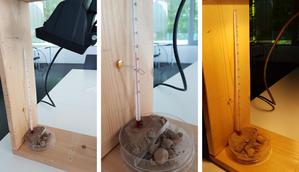Glossary term: 熱輻射
Description: 所有物體都會發出與其溫度直接相關的電磁輻射。這種輻射稱為熱輻射。在足夠高的溫度下,有些熱輻射是肉眼可見的,例如:滾燙的爐灶、加熱元件或火鉗會發出紅光;熔化的金屬會發出黃白色的光;在某些焊接過程中會發出藍白色的光,因此聰明的焊工需要佩戴護目鏡。對於較冷的物體,我們看不到發光,但這些物體會發出紅外線範圍內的熱輻射或無線電波。
最簡單的熱輻射形式是 "黑體輻射":黑體輻射 "是由一個理想物體髮出的熱輻射,該物體無視波長大小,吸收所有進入的輻射。該輻射的光譜(輻射能量如何在不同波長之間分布的信息)由一個稱為普朗克曲線的數學函數控制,它只取決於物體的溫度。普朗克曲線還規定,熱輻射輸出的總能量隨溫度的升高而陡增。
我們從恆星中接收到的輻射就是比較符合普朗克曲線的熱輻射。因此,我們可以為每顆恆星設定一個 "有效溫度"。溫度為 5500 攝氏度(5780 開爾文)的太陽閃耀著各種顏色,加起來就是我們定義的白色。有效溫度較低的恆星呈現紅色,如紅巨星或紅矮星。溫度較高的恆星呈現藍色,通常非常明亮。在幾萬甚至幾百萬度的溫度下,大部分熱輻射都是在紫外線、X 射線甚至伽馬射線區域發出的。
熱輻射與熱平衡的概念有關。如果物體的溫度相同,它們就處於熱平衡狀態。熱輻射是物體努力與彌漫整個空間的電磁場達到熱平衡的結果。
Related Terms:
See this term in other languages
Term and definition status: The original definition of this term in English have been approved by a research astronomer and a teacher The translation of this term and its definition is still awaiting approval
This is an automated transliteration of the simplified Chinese translation of this term
The OAE Multilingual Glossary is a project of the IAU Office of Astronomy for Education (OAE) in collaboration with the IAU Office of Astronomy Outreach (OAO). The terms and definitions were chosen, written and reviewed by a collective effort from the OAE, the OAE Centers and Nodes, the OAE National Astronomy Education Coordinators (NAECs) and other volunteers. You can find a full list of credits here. All glossary terms and their definitions are released under a Creative Commons CC BY-4.0 license and should be credited to "IAU OAE".
If you notice a factual or translation error in this glossary term or definition then please get in touch.
Related Activities
Oceans As A Heat Reservoir
astroEDU educational activity (links to astroEDU website) Description: Why do oceans play an important role in mitigating global warming?
License: CC-BY-4.0 Creative Commons 姓名標示 4.0 國際 (CC BY 4.0) icons
Tags:
Life
, Climate change
, Oceans
, heat
Age Ranges:
12-14
, 14-16
, 16-19
Education Level:
Middle School
Areas of Learning:
Modelling
, Social Research
, Traditional Science Experiment
Costs:
Medium Cost
Duration:
1 hour 30 mins
Group Size:
Group
Skills:
Analysing and interpreting data
, Constructing explanations
, Developing and using models
, Engaging in argument from evidence
, Planning and carrying out investigations









